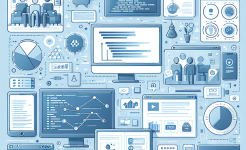Agile stand-up meetings are a cornerstone of Agile project management, designed to foster communication, collaboration, and transparency within a team. These daily, short meetings serve as a platform for team members to share progress, discuss challenges, and align their efforts towards the project goals. However, ensuring information transparency in these meetings can be a complex task, especially in diverse teams with different communication styles and levels of experience. Transparency is not just about sharing information; it's about sharing the right information, in the right way, at the right time. When information is transparent in stand-up meetings, it helps in early identification of issues, better decision-making, and ultimately, the successful delivery of the project. In this article, we will explore various strategies to ensure information transparency in Agile stand-up meetings.
Clear Meeting Objectives
The first step in ensuring information transparency is to have clear meeting objectives. Stand-up meetings are not meant for in-depth discussions or problem-solving; their primary purpose is to provide a quick update on the team's progress. By setting clear objectives, team members know exactly what is expected of them. For example, the objective could be to share what was accomplished yesterday, what will be done today, and any obstacles that are preventing progress. This clarity helps in focusing the conversation and ensures that relevant information is shared. When team members understand the purpose of the meeting, they are more likely to prepare and present their updates in a concise and transparent manner. It also helps in avoiding unnecessary tangents and keeps the meeting on track. Clear objectives act as a guiding light, ensuring that the information shared is relevant and useful for the entire team.
Moreover, communicating these objectives clearly to all team members is crucial. This can be done through team guidelines, onboarding processes, or simply by reminding the team at the start of each meeting. When everyone is on the same page regarding the purpose of the stand-up, it becomes easier to maintain transparency. New team members, in particular, benefit from this clarity as they quickly understand the norms and expectations of the meeting. It also helps in standardizing the information shared across the team, making it easier to compare progress and identify trends. By having a well-defined purpose, stand-up meetings become a reliable source of information, enhancing transparency and trust within the team.
In addition, the meeting objectives should be flexible enough to adapt to the changing needs of the project. As the project progresses, new challenges and requirements may arise, and the stand-up meeting objectives should be adjusted accordingly. This flexibility ensures that the information shared remains relevant and valuable. For instance, if the project enters a testing phase, the objectives could include sharing test results and any bugs found. By aligning the objectives with the project stage, the stand-up meeting becomes a more effective tool for information sharing and transparency.
Standardized Reporting Format
A standardized reporting format is essential for ensuring information transparency in stand-up meetings. When team members follow a consistent structure for sharing their updates, it becomes easier to understand and compare the information. For example, a common format could be the "What I did yesterday, What I will do today, and Any impediments" structure. This simple yet effective format allows everyone to quickly grasp the key points of each team member's update. It also helps in identifying patterns and trends across the team. If multiple team members report similar impediments, it signals a larger issue that needs to be addressed.
The standardized format should also include guidelines on the level of detail required. While it's important to be concise, team members should provide enough information to give a clear picture of their progress. For example, instead of saying "Worked on the feature," a more detailed update could be "Completed the coding for the user registration feature and started the initial testing. Discovered a bug in the password validation process." This level of detail helps in better understanding of the work done and the challenges faced. It also enables the team to make more informed decisions and provide more targeted support.
Furthermore, the reporting format should be adaptable to different types of projects and teams. Some teams may require additional fields, such as the status of dependencies or the use of specific tools. By customizing the format to suit the team's needs, it ensures that all relevant information is captured. This customization also helps in promoting ownership and engagement among team members. When they feel that the reporting format is tailored to their work, they are more likely to provide accurate and detailed updates, further enhancing information transparency.
Active Listening and Engagement
Active listening is a key aspect of ensuring information transparency in stand-up meetings. When team members listen attentively to each other's updates, it shows respect and helps in building trust. It also allows them to understand the context and implications of the information shared. For example, if a team member mentions an impediment, active listening enables others to identify potential solutions or offer support. By paying close attention, team members can pick up on subtle cues and details that may be crucial for the project's success.
In addition to listening, engagement is equally important. Team members should be encouraged to ask questions, provide feedback, and offer suggestions during the stand-up meeting. This interaction not only helps in clarifying information but also promotes collaboration and innovation. For instance, if a team member shares a new approach to a problem, others can offer their perspectives and insights, leading to a more comprehensive solution. Engagement also makes the stand-up meeting more dynamic and interesting, increasing the likelihood of team members actively participating and sharing information.

To foster active listening and engagement, the meeting environment should be conducive. This includes minimizing distractions, such as turning off mobile devices and avoiding side conversations. The meeting leader should also set a positive tone by encouraging open communication and respecting different viewpoints. By creating a safe and supportive space, team members feel more comfortable sharing their thoughts and concerns, leading to greater information transparency.
Use of Visual Aids
Visual aids can significantly enhance information transparency in stand-up meetings. Tools such as task boards, burndown charts, and Kanban boards provide a visual representation of the project's progress. These visual aids make it easier for team members to understand the overall status of the project at a glance. For example, a task board with cards representing different tasks can show which tasks are in progress, completed, or blocked. This visual representation helps in quickly identifying bottlenecks and areas that need attention.
Visual aids also facilitate communication and collaboration. Team members can refer to the visual aids during the stand-up meeting to support their updates. For instance, a team member can point to a specific task on the board and explain its progress. This makes the information more tangible and easier to understand. It also allows for better comparison of progress across different team members and tasks. Visual aids can also be used to track dependencies and relationships between tasks, providing a more holistic view of the project.
Moreover, the use of visual aids promotes transparency by making the information accessible to everyone. Whether it's a physical board in the office or a digital tool accessible online, all team members can view and interact with the visual aids. This accessibility ensures that everyone has the same information, reducing the chances of miscommunication and misunderstandings. Visual aids also serve as a historical record of the project's progress, allowing team members to review and analyze trends over time.
Addressing Information Asymmetry
Information asymmetry can be a major obstacle to transparency in stand-up meetings. This occurs when some team members have more information than others, leading to misunderstandings and inefficiencies. To address this issue, it's important to promote a culture of open communication and knowledge sharing. Team members should be encouraged to share any relevant information, even if they think it may not be important. For example, if a team member has knowledge about a potential risk or a new industry trend, they should share it during the stand-up meeting.
In addition, the meeting leader should play a role in ensuring that all team members have access to the necessary information. This can involve providing updates on project-wide initiatives, sharing relevant documents, or facilitating knowledge transfer sessions. By making sure that everyone is well-informed, it reduces the information gap and promotes transparency. The meeting leader can also encourage team members to ask questions and seek clarification if they feel they are missing some information.
Furthermore, cross-functional teams may face unique challenges in terms of information asymmetry. Different departments may have different jargon, processes, and levels of expertise. To overcome this, team members should be trained on basic concepts from other departments. This cross-training helps in better understanding and communication. For example, a developer may benefit from learning about the testing process, and a tester may gain insights into the development workflow. By breaking down these silos, information transparency is enhanced, and the team can work more effectively towards the project goals.
Conclusion
Ensuring information transparency in Agile stand-up meetings is crucial for the success of any project. By following the strategies outlined in this article, teams can enhance communication, collaboration, and overall project performance. Clear meeting objectives provide a focus for the information shared, while a standardized reporting format makes it easier to understand and compare updates. Active listening and engagement promote interaction and innovation, and the use of visual aids provides a visual representation of the project's progress. Addressing information asymmetry helps in reducing misunderstandings and ensuring that all team members are well-informed.
In conclusion, transparency in stand-up meetings is not a one-time effort but an ongoing process. It requires commitment from all team members, including the meeting leader. By continuously evaluating and improving the meeting processes, teams can create an environment where information flows freely and everyone is working towards a common goal. Transparent stand-up meetings not only lead to better project outcomes but also contribute to a positive team culture based on trust and collaboration. As Agile methodologies continue to evolve, the importance of information transparency in stand-up meetings will only increase, making it essential for teams to master these strategies for long-term success.
ARTICLE TITLE :How to ensure information transparency in Agile stand-up meetings ,AUTHOR :ITpmlib

















